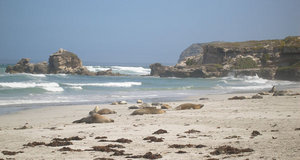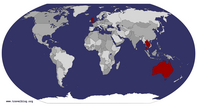Advertisement
Published: September 21st 2008

 Australian Fur Seals.
Australian Fur Seals.
Resting on the beach. They spend up to three days at sea foraging for food.Located 13 kilometers west of the Fleurieu and south of the Yorke peninsulas in South Australia, Kangaroo Island is Australia's third largest island after Tasmania and Melville Island. Its it approximately 155kms long and 55kms wide with a total area of about 4350 square kilometers. It population is 4350 people, 500,000 wallabies, 15,000 kangaroos and 25,000 koalas. Also amongst the inhabitants are echidnas, platypuses, sea lions, seals and dozens of bird species. Though I have lived many years in Adelaide, I have never visited. Now aboard a ferry boarded at Cape Jervis, on the tip of the Fluerieu Peninsula, I am hoping to meet a few of its citizens.
Landing at Penneshaw late in the afternoon I decide to drive to the town of American River for my first night on the island. A small community of about 200 people, its main industries are tourism and oyster farming. As the maritime enviroment around American River is a breeding ground for many species of fish it has been made a part of the national estate.
The
Seal Bay Conservation Park located on the southern coast of the island is home to a breeding colony of approximately 600 Australian seal lions.

 Helictites.
Helictites.
These structures which seem to grow in all directions are a feature of the Kelly Hill caves.In the 1800's they were almost hunted to extinction for their skins and blubber. Actually their skins did not make very goods furs because the hair is too coarse. Aboriginal women were kidnapped from Tasmania and the mainland to assist in the capture of seals and for other purposes. Though Aborigines live on Kangaroo Island more than 15000 years ago they vanished centuries before the arrival of Europeans. Observing seals can be done from a a fenced board walk, which does not allow access to the beach, or directly on the beach in the company of a Ranger. In addition to breeding, seals use the beach, Bales Beach, to rest between diving periods foraging for food. They spend up to three days at a time out at sea performing up to 500 dives. Some are injured and killed by the Great White Sharks that cruise the area. If a seal is injured the policy is to not attend to their injuries as that is considered to be interfering with nature. On the beach tourists are expected to keep a respectable distance from the seals. This is partly to protect the seal but also to protect the humans. Though relatively tolerant

 Lighthouse
Lighthouse
The light at Cape du Couedic was built of local sandstone between 1906-09.of people compared to most seal colonies they are still wild animals.
Next stop is Vivonne Bay, reported to be the best beach in Australia. May be, my own personal opinion for what it is worth is that it is an OK beach, but the best in Australia, I think not. However it was certainly good enough to spend the night.
First stop today is
Kelly Hill Caves about 15 kilometers west of Vivonne Bay. They were named Kelly Hill Caves because of a horse called Kelly 'discovered' them by falling into a sinkhole. While Kelly's rider, a man named Kelsy, made it back to the surface, poor Kelly wandered off into the labyrinth and was never seen again 😞 Well that was the story but maybe it is a horse tale. After buying my ticket at the visitors center I walk about 500 meters up a gentle incline to the caves entrance, or should I say a small shed with a locked door which has been built over the cave entrance. Eventually the ranger emerges, and after releasing his previous quests he guides us down a step downwards stairway into the belly of the cave. It is

 Admirals Arch
Admirals Arch
New Zealand fur seals like to rest on smooth rocks. cooler underground than on the surface during this warm day. Actually the cave's temperature is fairly constant and on cold days can feel warmer than the surface. Inside is the usual stalactites and stalagmites, and features such as the 'ballerina shoe' that are found in any cave. Of more interest are formations called helictites. These are a distorted form of stalactite which instead of growing down can grown in multiple directions, even up. The reason for this is not clear, one theory attributes it to capillary action within the structure yet another lists the cause as wind. Recently the caves were fitted with fibre optic white lighting. As well as saving power it illuminates structures with white light allowing their 'true' colours to be perceived. We are also given a demonstration of the candle lighting used in the early days of cave exploration. Lighting our candles we follow the path, the candle light revealing very little. Our tour over, we now have to climb the same steep stair case back to the surface.
A light-house was constructed at
Cape du Couedic located at the south - west extremity of Kangaroo Island between 1906-09. It was built with about 2000

 Remarkable Rocks
Remarkable Rocks
Are formations known as iselbergs. The orange colour on them are lichens.pieces of local sandstone. Its light can be seen up to seventeen kilometers out to sea. A little to the south of the light house is an area known as Casurina Inlet including Admirals Arch, which is home to another colony of fur seals, this time the New Zealand fur seal. Whereas the colour of Australian fur seal ranges from sandy grey to grey-brown, the NZ seal ranges from dark grey to brown. They have a narrower face with and upturned nose. When resting the Australian fur seals tend to huddle together whereas the NZ seals tend to avoid body contact. Movement is different too, the Australian seal moving with a walking gait whereas the NZ seals tend to hop. The Australian seal make a deep honking or barking sound whereas the NZ seal emit a high-pitched sequel. NZ seals have a very thick underfur, up to 15000 hairs/ square centimeter which means their skin never gets wet however they are prone to getting hot when basking in the sun, and need to take frequent dips to cool off. The Australian seal on the other hand has relatively coarse hair with no underfur allowing them to spend more time resting

 Beach
Beach
Spray covered beach on southern Kangaroo Island. The Remarkable Rock can be seen.
in the sun. Both seals move inland amongst the bushes to escape wind and sun.
A few kilometers east of Cape du Couedic reach by a side road and a walk along a board walk is a formation called the
Remarkable Rocks. They are a granite outcrop known as an iselberg which have been sculptured by an abstract artist. His name is Wind, Sea and Time. The orange colouring on the granite is a slow going organism called lichen. Lichen is the only living organism that can survive solely on bare rocks. They secrete acids which dissolve the rock releasing its minerals and nutrients. The process creates soil. Grey and green lichens grow in less exposed areas. Around the rock are boundaries marking the limits of where people should go. This is because the rocks are prone to be washed over by swells coming in from the Southern Ocean. If a person gets swept of the rocks by a swell they may never been seen or heard of, again. Back toward the road to Cape du Couedic is a lookout where views back to the Remarkable Rocks over a deserted windswept spray enveloped beach can be enjoyed. While I

 Koala
Koala
Though introduced to the island they thrive to such an extent that some had to be sterised to keep the population under control.was there a tourist bus stopped. Out they came, snap, snap, snap sounded the cameras and then back in the bus, GONE!! Did they experience anything? I am experiencing the closing of the day, when due to my own disorganisation, pondering wind and wave actions over the millennia gives away to mundane thoughts of a room for the night.
Next day while traveling to Kingscote I stop in at the
Parndana Wildlife Park. While it has a large collection of birds and native animals such as koalas, wallabies, echidnas and red kangaroos they where in small netted cages which detracted from the idea of being a wild life park. Admittedly it allows people to get up close to the animals and birds but I was expecting something more like a free range park rather than the birds and animals being in cages.
Surprising koalas are not native to Kangaroo Island but were introduced in the 1920s. This was to protect them from threatened mainland extinction due to hunting, disease, fire and lost of habitat. They thrived here to such an extent that they defoliated large areas of the island. It was therefore for some to be sterilised.

 Emu-Bay
Emu-Bay
On a lanquid sunny day, the rest of the world definitely does not exist.with a population around 1200 is Kangaroo Island's largest town. It is also South Australia's oldest European settlement and was briefly considered a possible capital of South Australia. But later that year, 1836, a colony was established at Glenelg now a beach side suburb of the capital Adelaide. A pleasure in Kingcote is dining while enjoying panoramic views of Nepean Bay.
A final side trip was to nearby
Emu Bay. On a warm languid day, with no other people in site, the rest of the world really ceases to exist. But alas, I have not given myself enough time, for later today a ferry will be waiting at Penneshaw.
Advertisement
Tot: 0.144s; Tpl: 0.013s; cc: 14; qc: 54; dbt: 0.0586s; 1; m:domysql w:travelblog (10.17.0.13); sld: 1;
; mem: 1.1mb











